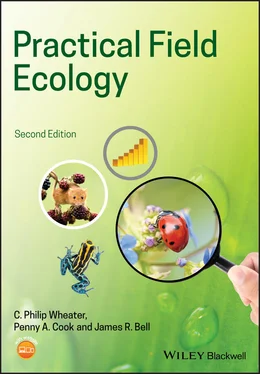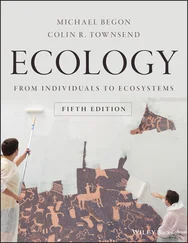4 Chris Bennett (Rothamsted Research) – plants;
5 Dan Blumgart (Rothamsted Research and Lancaster University) – moth traps;
6 David Brown (University of Cardiff) – snakes;
7 Friederike Clever (MMU) – coral reef fish poster;
8 Jordan Cuff (Cardiff University) – DNA metabarcoding;
9 Robin Curtis (University of Exeter) – butterflies;
10 Jenny Jacobs (Rothamsted Research) – bees;
11 Vicky Larcombe (née Oglivy) (Froglife) – tree frogs;
12 Erica McAlister (Natural History Museum, London) – insects;
13 Stuart Marsden (MMU) – parrots;
14 Helen Read (Burnham Beeches) – trees;
15 Jo Setchell (University of Durham) – mandrills;
16 Emma Shaw (MMU) – tarantulas;
17 Roisin Stanbrook (University of Central Florida) – dung beetles;
18 Christopher Todd (University of St Andrews) – barnacles;
19 Gareth Williams (Bangor University) – marine microbes;
20 Ian Winfield (CEH, Lancaster) – fish;
21 Matt Zeale (University of Bristol) – bats.
Thanks to the Ordnance Survey for permission to use the map fragment in Figure 2.1. All images are used with permission and are marked with the appropriate initials (e.g. JRB – James Bell, PAC – Penny Cook, and CPW – Philip Wheater). The Park Grass photograph is courtesy of Rothamsted Research (RRES). In addition to those mentioned above who supplied images as part of their case studies, we thank the following for supplying images:
| Sandra Baker (SB); Friederike Clever (FJC); Fraser Combe (FC) Sam Cook (SC); Matthew Dennis (MD); Mike Dobson (MKD); Hannah Dugdale (HD); Mike Edwards (ME); Paul Higginbottom (PH); Jonathan Lageard (JGAL); |
Mark Langan (AML); Mark Mallott (MM); Sharon Matola (SM); Kelly Reynolds (KR); Miira Riipinen (MR); Rob Robinson (RAR); Emma Shaw (ES); Chris Shortall (CS); Nigel Stork (NES); Rob Strachan (RS). |
A huge thanks to all those generations of students and colleagues on many a field course, expedition, or research trip who commented on the early and developing ideas behind this book, discussed the merits of particular techniques, the ways in which to introduce the information to students, and the intelligibility (or otherwise) of the handouts and other teaching materials from which this text derives. JRB would like to thank Ian Denholm for his support and members of PIE for their varied contributions. Finally, thanks to all of those who have supported us and suffered during the writing of this book. CPW and PAC would particularly like to thank Abhishek Kumar, Charlotte, and Henry. JRB is especially grateful to his family and to his friends at Rothamsted for their support.
About the Companion Website
Don't forget to visit the companion website for this book:
www.wiley.com/go/wheater/practicalfieldecology 
There you will find valuable material designed to enhance your learning, including:
simple statistics package (FCStats) for use with ecological data
art work for each chapter
weblinks for each chapter
keys to surface active invertebrates
weblinks for each chapter (including many references).
Scan this QR code to visit the companion website.

For many students, honing their research skills is an important component of their academic development. However, inexperienced researchers can be naïve in their approach, and may even attempt highly complicated studies that have little chance of being completed in the time, and with the resources, available. This chapter describes the thought and preparation needed to plan your project, particularly how to formulate your ideas into something structured and workable before going out into the field. In your research, you will search for explanations or patterns, make comparisons, predictions and generalisations, and formulate theories. Research is not simply an exercise in information gathering. Rather, research is about asking questions that go beyond description and require analysis. Your research will be highly individual, and there are no set outcomes. You will form your own opinion, even if this disagrees with previous work. This is because progress in science results from the continual testing, review, and criticism of other researchers' work. Do not expect your research project to answer all your original questions. It is much more typical to find that research generates more questions than it answers. Research submitted for publication or for examination should show evidence of originality. Even if your research is not wholly original, it can show evidence of original thinking. Although the prospect of carrying out original research may seem rather daunting, providing you do not exactly copy someone else's experimental design, methods, sites, etc., your research is almost certainly going to be original. There are several ways in which work can be original:
Executing an entirely new piece of work (e.g. studying a plant or animal for which there is little or no information currently available).
Adding knowledge in a way that has not been previously done before. Many empirical studies do not develop new topics to study but instead advance their work with the use of original experimental designs, new statistical methods, etc. For example, new insights might be generated from exploring the ecology of an otherwise well‐studied animal at different sites to see whether a behaviour or food preference differs between locations.
By testing somebody else's idea, or by carrying out an established idea in a new area, new experimental subject, etc., or by using existing data to develop new interpretations.
Continuing an existing piece of work that is ongoing at your university or with a partner institution. For example, there are many long‐term experiments that invite students to participate in summer work. These opportunities can be symbiotic and provide both you and the scientist running the project with more data that could elucidate a mechanism or generate new hypotheses.
Originality may only be apparent in the breath of the study. Increasingly popular is ‘cross‐disciplinary’ science where, for example, soil scientists, botanists, and entomologists converge on a subject matter or site and work together to test an over‐arching hypothesis.
All research, whether taking place in the laboratory or field, needs careful planning. It is perhaps self‐evident that such planning should involve the correct use of equipment and choice of appropriate sampling methods and collection sites. In addition, a wide range of associated logistic, legal, and health and safety implications need to be considered. Although many of these issues are equally important in field or laboratory‐based investigations, field research may be more limited by time and other factors (access to sites, time of year, weather conditions) than is laboratory research. Thus, field study may need more careful consideration prior to implementation. Chapter 1 details some of the issues involved in planning and designing fieldwork, and culminates in a checklist that may help to prevent problems once research is implemented. Chapter 2deals with the techniques required for monitoring sampling sites and measuring physical and chemical factors. Chapter 3covers the methods used to sample static or relatively immobile organisms, whilst Chapter 4extends this concept to studying mobile animals. The latter includes a consideration of monitoring behaviour and of dealing with both direct and indirect observations, as well as covering the trapping and marking of individual animals. In Chapter 5we summarise a large number of different approaches suitable for the statistical analysis of ecological data. Finally, in Chapter 6we cover how to present your results and produce appropriate reports, posters, and presentations.
Читать дальше














